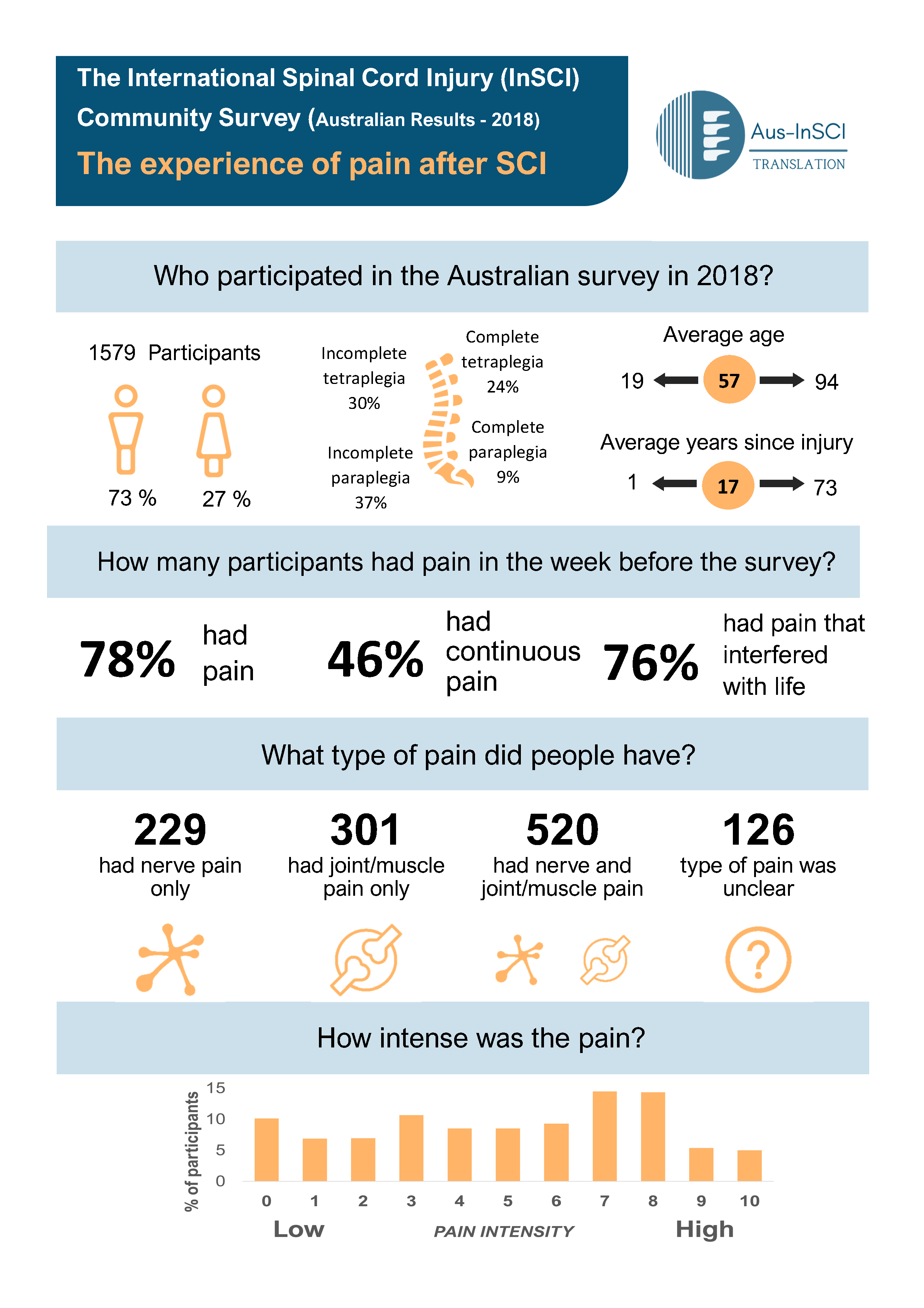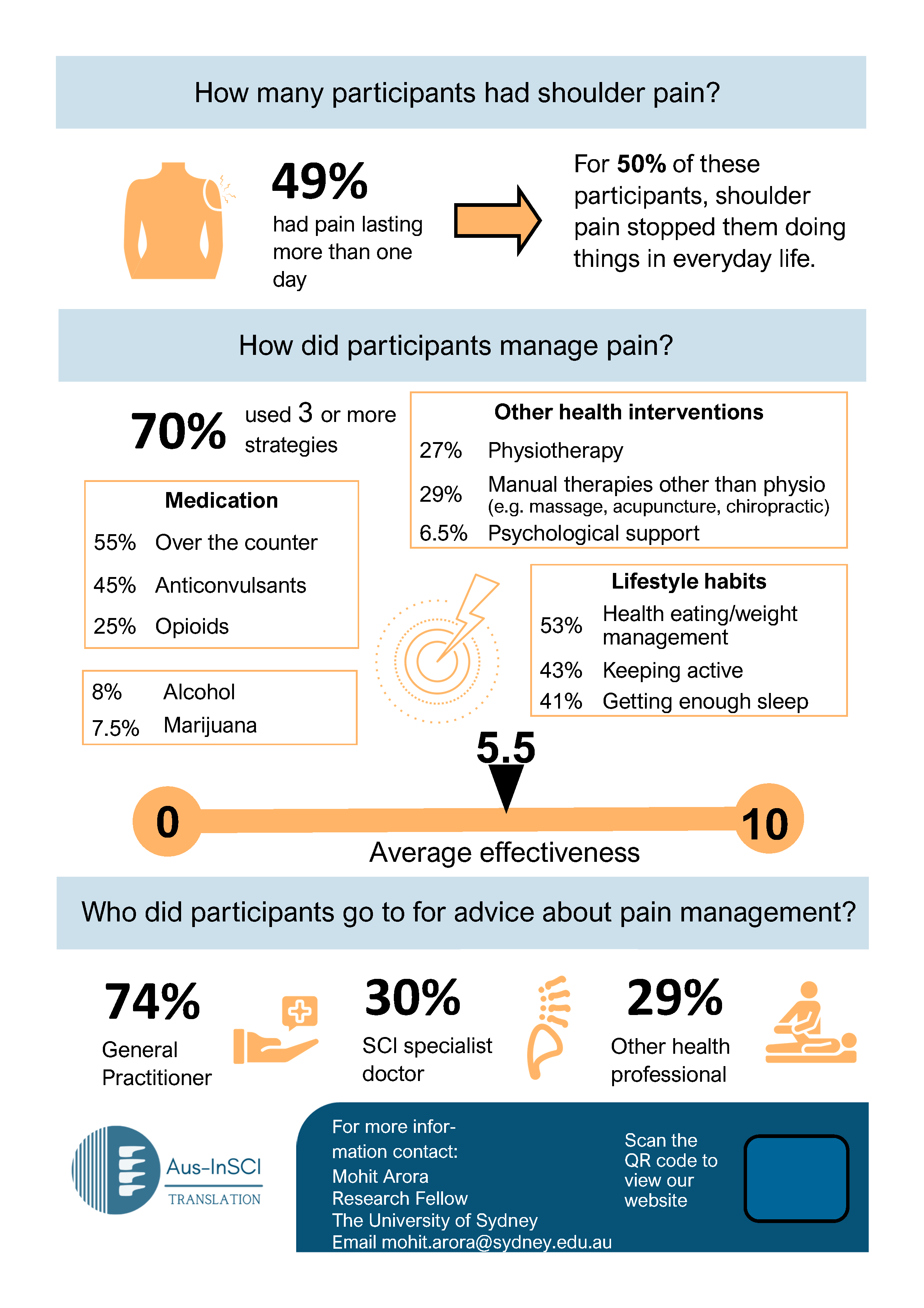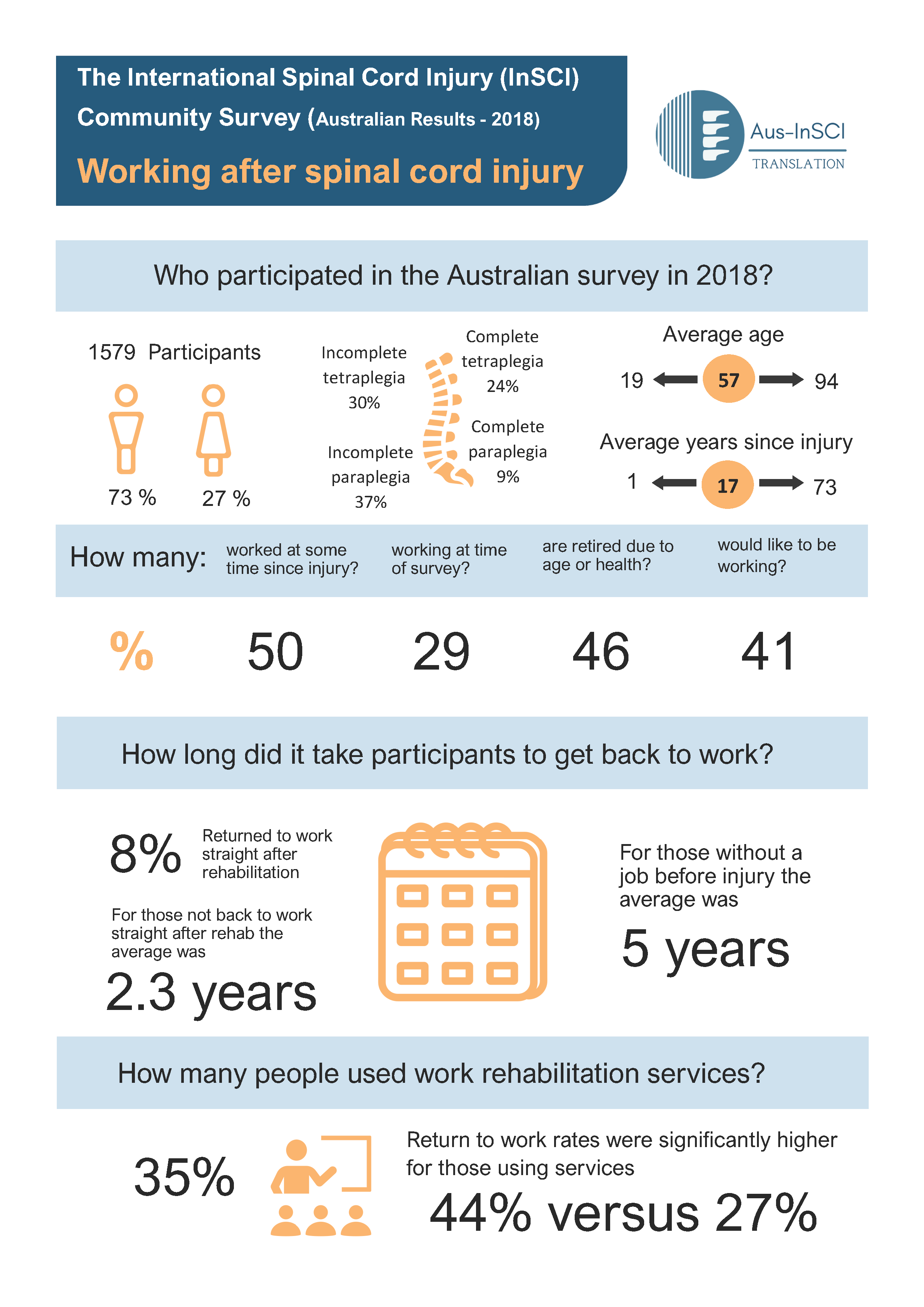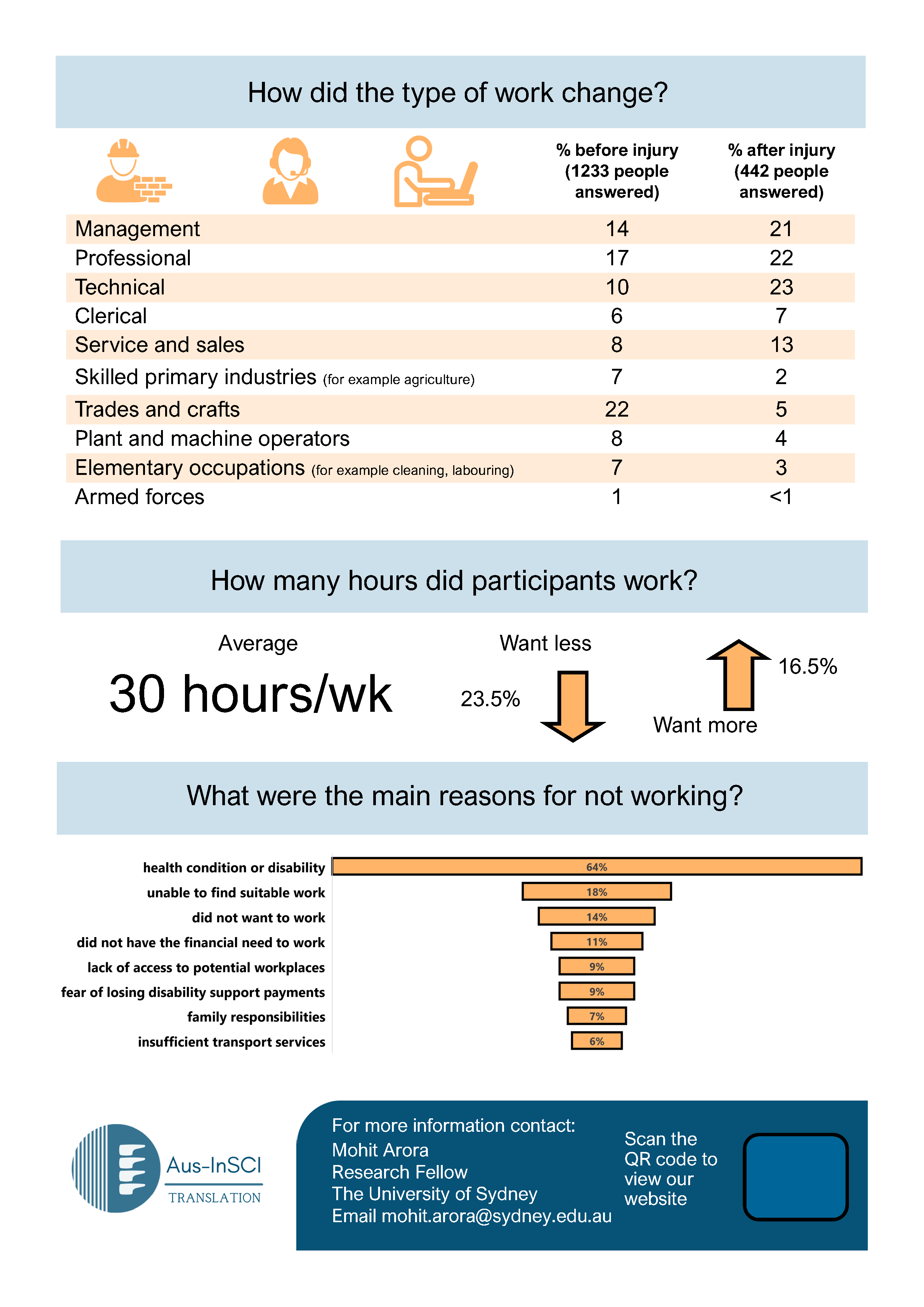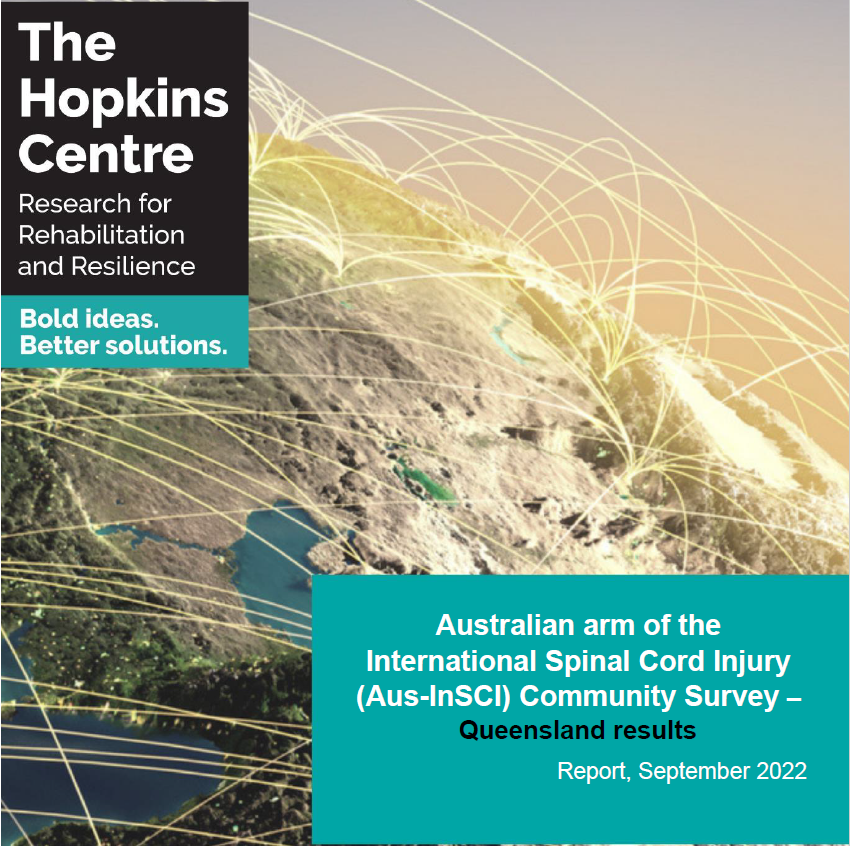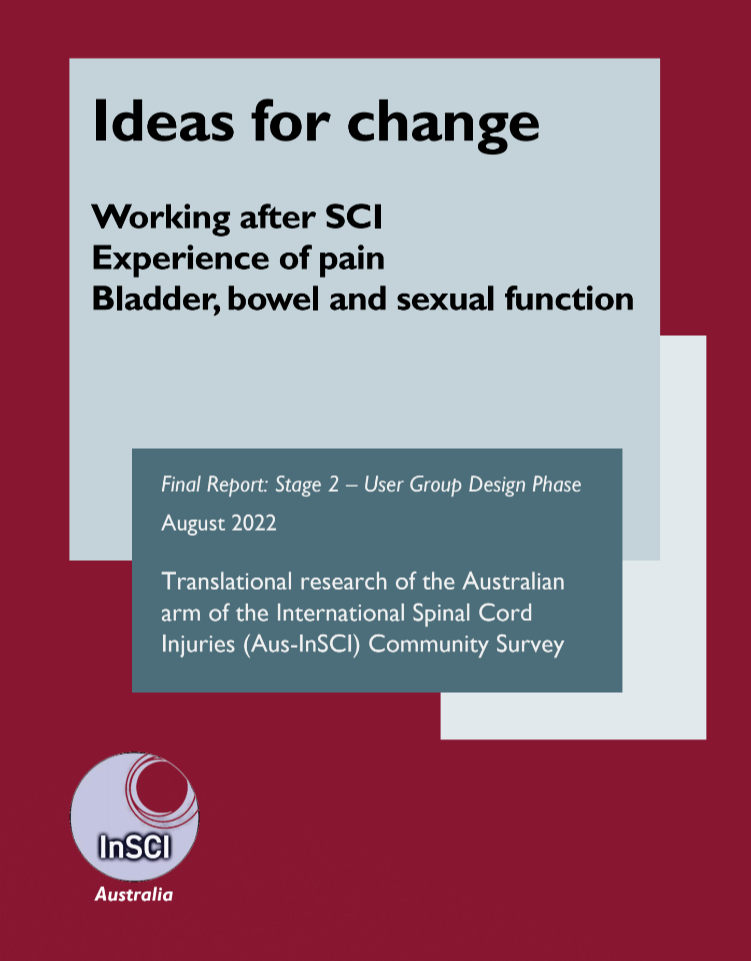The International Spinal Cord Injury (InSCI) Community Survey Project and Australian arm (Aus-InSCI)
About the Project
The International Spinal Cord Injury (InSCI) Community Survey is the first ever worldwide survey for people with spinal cord injury (SCI) living in the community. It forms part of a Learning Health System for SCI and is linked with wider initiatives, in particular the World Health Organization (WHO) Rehabilitation 2030, a Call for Action. Australia is one country among many others taking part in this project to capture the lived experience of people with spinal cord injury (SCI) by asking those who know best: people with lived experience of SCI. The project is a survey for people with spinal cord injury (SCI) living in the community who have been discharged from a rehabilitation facility for at least 12 months.
In 2018, the first Community Survey took place and was completed by 1579 Australians across Victoria, New South Wales, South Australia and Queensland. The Australian arm of InSCI is known as Aus-InSCI Community Survey. The InSCI 2018 Community Survey was just the beginning of our work to better understand the needs and circumstances of people with SCI. We are currently in the process of conducting a five-year follow-up Survey, as one of more than 40 countries participating in the second InSCI Community Survey. This is a national project that is being led by Professor James Middleton (Lead) and Dr Mohit Arora (Co-Lead) of the John Walsh Centre for Rehabilitation Research, The Kolling Institute, Faculty of Medicine and Health, University of Sydney.
Click to here to read about the Aus-InSCI Translation Project that is translating these survey findings into practical and co-designed solutions.
What is the InSCI Community Survey about?
With more than 20,000 Australian people, and their families, impacted by spinal cord injury (SCI), we need to know more about how we can better understand and support this community.
In 2018, Australia joined the International Spinal Cord Injury Community Survey with 21 other countries from different regions of the world. During the research, Australian participants completed a Survey questionnaire of 193 questions – some questions for everyone around the globe, and some just for our local Australians. We aimed to learn more about the function, health and wellbeing of people with spinal cord injury, their problems and needs, so we can identify ways we can help them live to their full potential. The Community Survey included questions about:
- Health and wellbeing
- Work and employment
- Level of functioning and environmental factors
- Quality of life and social factors
- Australian participants were also asked about pain, physical and social activity, and sleep and fatigue.
Click here to download the What Is InSCI Infographic.
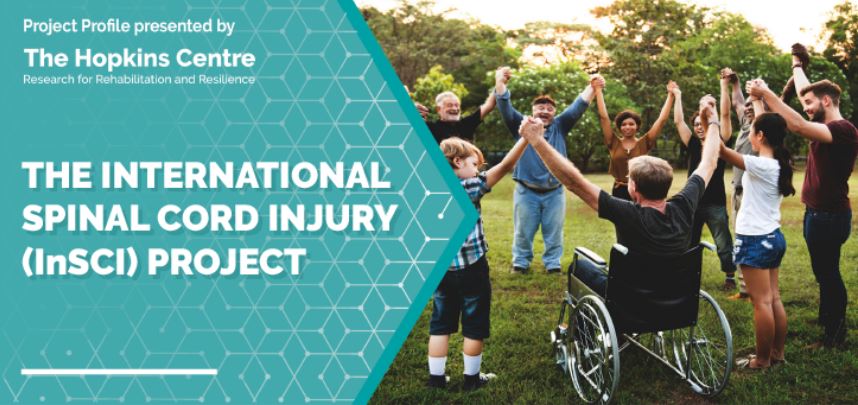
![]() Click here to download Project Flyer
Click here to download Project Flyer
Who took part in the 2018 Community Survey?
People aged 18 and over, with traumatic or non-traumatic SCI residing in the community and more than 12-months past their injury were asked to participate.
1579 people responded, representing:
- 73% males, 27% females
- Injury: Incomplete tetraplegia 30%, Incomplete paraplegia 37%, Complete tetraplegia 24%, Complete paraplegia 9%
- Average age: 57
- Years since injury: 17
What were the findings from the first Community Survey?
General findings
Daily life
Most people rated their quality of life as good or very good, but still experience regular challenges.
- 29% said accessing public transport is a problem
- 26% said using hands and fingers is a problem
_Page_1%20(1).png)
_Page_2%20(1).png)
![]() For more information click here to download the 2018 Australian Results Infographic.
For more information click here to download the 2018 Australian Results Infographic.
Bladder problems
Problems with the bladder were very common among people with spinal cord injuries.
- 60% had problems
- 12% had extreme problems
- 34% had an indwelling catheter
- 48% had urinary tract infections
.pdf_Page_1.png)
.pdf_Page_2.png)
Experiencing pain
Pain is an ever-present part of the lives of many people with spinal cord injury.
- 46% experience continuous pain
- 41% saw a physio in last 12-months
- 44% had nerve and joint/muscle pain
- 70% use three or more strategies to manage pain
For more information click here to download the Pain after SCI Infographic.
Employment
Most people with a spinal cord injury wanted to work, but for some, managing their health and finding suitable work was an overwhelming challenge.
- 50% worked at some point since injury
- It took an average of 2.3 years to get back to work
- 35% used work rehabilitation services
- Participants worked on average 30 hours per week
For more information click here to download the Working after SCI Infographic.
Other Information / Translation Outputs
Translation is the process of using the research findings to make positive changes to the way problems that people with SCI are having are addressed by health professionals or to make changes to policies affecting people with SCI at a system level e.g. government or other organisations.
Our Publications
There were many areas of interest from the 2018 Community Survey. The project team has been working on distributing this information in the form of publications. There are publications that are still in progress, however, the following papers have now been published.
- Borg, S.J., Geraghty, T., Arora, M., Foster, M., Marshall, R., Nunn, A. & Middleton, J.W. (2021). Employment outcomes following spinal cord injury: A population-based cross-sectional study in Australia. Spinal Cord, 59(10), 1120-31.
- Borg, S.J., Borg, D.N., Arora, M., Middleton, J.W., Marshall, R., Nunn, A. & Geraghty, T. (2022). Factors related to engagement in employment after spinal cord injury in Australia: A cross-sectional study. Archives of Physical Medicine and Rehabilitation, 103(12), 2345-2354. https://doi.org/10.1016/j.apmr.2022.04.011
- Graco, M., Arora, M., Berlowitz, D.J., Craig, A. & Middleton, J.W. (2023). The impact of sleep quality on health, participation and employment outcomes in people with spinal cord injury. Annals of Physical and Rehabilitation Medicine, 66(5), article 101738. https://doi.org/10.1016/j.rehab.2023.101738
- Kifley, A., Arora, M., Nunn, A., Marshall, R., Geraghty, T., Weber, G., Urquhart, S., Craig, A., Cameron, I.D. & Middleton, J.W. (2023). Australian arm of the International Spinal Cord Injury (Aus-InSCI) Community Survey: 3. Drivers of quality of life in people with spinal cord injury. Spinal Cord, 61(3), 185-193. https://doi.org/10.1038/s41393-022-00845-3
- Kifley, A., Geraghty, T.J., Arora, M., Bourke, J., Craig, A., Cameron, I., Nunn, A., Marshall, R. & Middleton, J.W. (2023). Complex lived experiences and hidden disability after spinal cord injury: a latent profile analysis of the Australian arm of the International Spinal Cord Injury (Aus-InSCI) Community Survey. Disability and Rehabilitation, 29, 1-12. https://pubmed.ncbi.nlm.nih.gov/38018422/
- Middleton, J.W., Arora, M., Kifley, A., Clark, J., Borg, S.J., Tran, Y., Atresh, S., Kaur, J., Shetty, S., Nunn, A., Marshall, R. & Geraghty, T. (2022). Australian arm of the International Spinal Cord Injury (Aus-InSCI) Community Survey: 2. Understanding the lived experience in people with spinal cord injury. Spinal Cord, 60(12), 1069–1079. https://doi.org/10.1038/s41393-022-00817-7
- Middleton, J.W., Arora, M., Kifley, A., Geraghty, T., Borg, S.J., Marshall, R., Clark, J., Nunn, A., Ferrante, A., Fekete, C., Stucki, G., Gopinath, B., Craig, A. & Cameron, I.D. (2023). Australian arm of the International Spinal Cord Injury (Aus-InSCI) Community Survey: 1. Population-based design, methodology and cohort profile. Spinal Cord, 61(3), 194-203. https://doi.org/10.1038/s41393-022-00850-6
- Watson, P.K., Arora, M., Middleton, J.W., Quel de Oliveira, C., Heard, R., Nunn, A., Geraghty, T., Marshall, R. & Davis, G.M. (2022). Leisure-time physical activity in people with spinal cord injury – Predictors of exercise guideline adherence. International Journal of Public Health, 67, article 1605235. https://doi.org/10.3389/ijph.2022.1605235
-
Borg, S. J., Borg, D. N., Arora, M., Middleton, J. W., Marshall, R., Nunn, A., & Geraghty, T. (2024). Unmet healthcare needs, access to services and experiences with health providers among persons with spinal cord injury in Australia. Spinal Cord. https://doi.org/10.1038/s41393-024-00997-4
-
Watson, P. K., Middleton, J. W., Arora, M., De Oliveira, C. Q., Heard, R., Nunn, A., Geraghty, T., Marshall, R., & Davis, G. M. (2025). Leisure-time physical activity in people with spinal cord injury: A population-based community sample. Topics in Spinal Cord Injury Rehabilitation, 31(2), 76–87. https://doi.org/10.46292/sci24-00007
-
Daniel, H., Bray, E. A., Beckman, E. M., Smith, K., Kendall, M., Tweedy, S., et al. (2025). Evaluation of an inpatient sports program to guide post-discharge physical activity participation among people with brain and spinal cord injury: A cross-sectional study. Disability and Rehabilitation, 1–16. https://doi.org/10.1080/09638288.2025.2527354
-
Watson, P. K., Middleton, J. W., Arora, M., Quel De Oliveira, C., Heard, R., Nunn, A., Geraghty, T., Marshall, R., & Davis, G. M. (2025). Leisure-time physical activity in people with spinal cord injury: A population-based community sample. Topics in Spinal Cord Injury Rehabilitation, 31(2), 76–87. https://doi.org/10.46292/sci24-00007
-
Mitchell, J., O’Loghlen, J., Bray, E., McLennan, V., McLeod, B., Brough, R., … Ownsworth, T. (2025). Assistive technology at work: a metasynthesis of the perspectives of people with spinal cord injury/damage. Disability and Rehabilitation: Assistive Technology, 1–20. https://doi.org/10.1080/17483107.2025.2475151
-
Bray, E., Brough, R., Jones, R., Burridge, L., Geraghty, T., Mitchell, J., … Ownsworth, T. (2025). Setting me up or holding me back? Perspectives of people with spinal cord injury on rehabilitation supports at inpatient discharge and 3-months post-discharge. Disability and Rehabilitation, 1–13. https://doi.org/10.1080/09638288.2025.2476037
-
Borg, S. J., Cameron, C. M., Luetsch, K., Rolley, A., Geraghty, T., McPhail, S., & McCreanor, V. (2024). Prevalence of opioid use in adults with spinal cord injury: A systematic review and meta-analysis. The Journal of Spinal Cord Medicine, 48(2), 170–188. https://doi.org/10.1080/10790268.2024.2319384
-
Borg, S. J., Borg, D. N., Wheeler, A., Atresh, S., & Geraghty, T. (2025). Prescription opioid dispensing rates in the 12-months post-discharge after acute spinal cord injury: An observational study. The Journal of Spinal Cord Medicine, 1–10. https://doi.org/10.1080/10790268.2024.2448043
Our reports
National Report: Australian arm of the International Spinal Cord Injury Community Survey (Aus-InSCI Community Survey)
- Middleton J, Arora M, Kifley A, Geraghty T, Marshall R and Nunn A (2021). Australian arm of the International Spinal Cord Injury (Aus-InSCI) Community Survey: National report to the National Steering Committee. The University of Sydney NSW Australia.
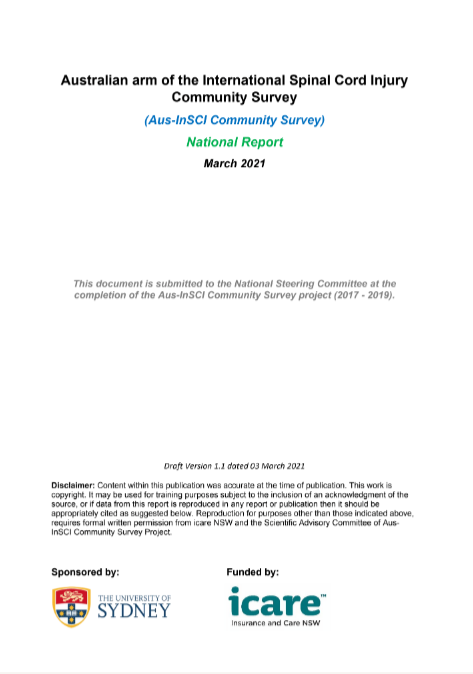
Queensland results of the 2018 InSCI Community Survey
This report presents key findings from the Community Survey for the 481 Queenslanders who completed the survey, including an overview of employment and health and secondary conditions.
- Geraghty T, Borg SJ. Australian arm of the International Spinal Cord Injury (Aus-InSCI) Community Survey – Queensland results. Report, September 2022.
Aus_InSCI 2018 Community Survey - Translation Report
This report is about a research project designed to translate the results from the Australian arm of the International Spinal Cord Injury (Aus-InSCI) Community Survey into positive change for people with SCI in Australia. Dr Delena Amsters presented on the Aus-InSCI Translation Project at a recent Hopkins Hour: Meaningful Research through Stakeholder Engagement on 17 May, 2023 (starts at minute 12:44). Click here to access a PDF version of the presentation delivered during this Hopkins Hour.
- Geraghty G, Amsters D, Borg S. Ideas for Change: Final Report: Stage 2 – User Group Design Phase, August 2022. Translational research of the Australian arm of the International Spinal Cord Injuries (Aus-InSCI) Community Survey.
Our Presentations
- Middleton J, Geraghty T, Kifley A, Jones T, Marshall R. Invited Workshop - Tackling hidden disability in people with spinal cord injury (SCI): it’s everyone’s business. Geraghty T: “Hidden disability in people with spinal cord injury - cauda equina syndrome with preserved ability to walk as an example” Australia and New Zealand Spinal Cord Society, Annual Scientific Meeting, Adelaide, 22/11/23.
- Middleton J, Geraghty T, Kifley A, Wynn R. Concurrent Workshop - Tackling hidden disability: It’s everyone’s business. 6th Annual Scientific Meeting, Rehabilitation Medicine Society of Australia and New Zealand. Hobart, Tasmania, 11/09/23.
- James W Middleton, Mohit Arora, Tim Geraghty, Ruth Marshall, Andrew Nunn & the Aus-InSCI group. Results of the International Spinal Cord Injury Survey in Australia (Aus-InSCI). International Spinal Cord Society Annual Scientific Meeting, Nice, France, 5-7 November 2019.
- Arora M, Geraghty T, Marshall R, Nunn A, Middleton JW for the Aus-InSCI group. Shoulder pain, it’s prevalence, patterns and impact on people with spinal cord injury in Australia: Sub-study of the Aus-InSCI community survey. International Spinal Cord Society Annual Scientific Meeting, Nice, France, 5-7 November 2019.
- Samantha Borg, Michele Foster, Timothy Geraghty. International Spinal Cord Injury Survey: Health characteristics and overview of community dwelling spinal cord injury patients in Queensland. Bold Ideas Better Solutions – The Hopkins Centre Symposium, Brisbane, 18th October 2019
- James W Middleton, Mohit Arora, Tim Geraghty, Ruth Marshall, Andrew Nunn & the Aus-InSCI group. Implementation and Results of the International Spinal Cord Injury (InSCI) Survey in Australia. Australia and New Zealand Spinal Cord Society Annual Scientific Meeting, Melbourne, 21-23 August 2019.
- Tim Geragthy, Sam Borg, Annette Kifley, Camila Quel De Oliveira. Hopkins Hour presentation - Understanding the lived experience of people with spinal cord injury: Update from the Australian arm International Spinal Cord Injury Community Survey Project (Aus-InSCI). 5 December 2024.
- Tim Geragthy, Sam Borg, Emily Bray, Soo Oh - ANZSCoS2024 Annual Scientific Meeting presentations 'unmet healthcare needs for people with spinal cord injury (SCI) in Australia''. 27-29 November 2024.
Who was involved in our project?
Our core research team
- Professor James Middleton (NSW)
- Dr Mohit Arora (NSW)
- Professor Ashley Craig (NSW)
- Dr Annette Kifley (NSW)
- Professor Ian Cameron (NSW)
- Adjunct Professor John Walsh AM (NSW)
- Professor Tim Geraghty (QLD)
- Ms Samantha Borg (QLD)
- Professor Ruth Marshall (SA)
- Dr Andrew Nunn (Vic)
Our translation core research team
- Professor Tim Geraghty (QLD)
- Ms Samantha Borg (QLD) - SRA
- Dr Delena Amsters (QLD)
- Professor James Middleton (NSW)
- Dr Mohit Arora (NSW)
Our new team members (joined 2022)
- Professor Glen Davis (NSW)
- Prof David Berlowitz (VIC)
- Dr Marnie Graco (VIC)
Our project partners
- iCare NSW
- Spinal Cord Injuries Australia, NSW
- Forward Ability Support (formerly known as ParaQuad), NSW
- Paraplegic and Quadriplegic Association of South Australia (PQSA)
- PHRN-CDL, Curtin University, WA
- Northern Sydney Local Health District, NSW
- South Eastern Sydney Local health District, NSW
- Royal Rehab, NSW
- Austin Health, VIC
- Lifetime Support, SA
- Central Adelaide Local Health Network, SA
- Princess Alexandra Hospital, QLD
- Spinal Life Australia, QLD and WA
- AQA, VIC
View All Researchers

